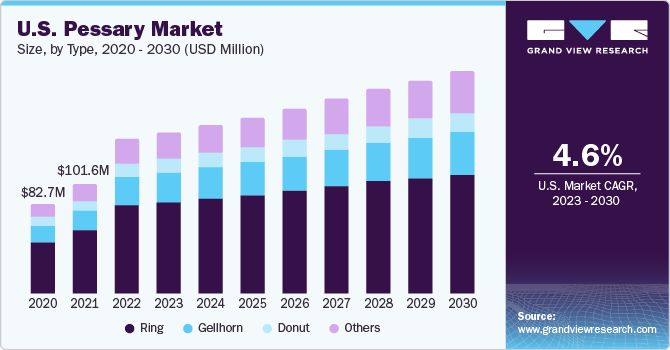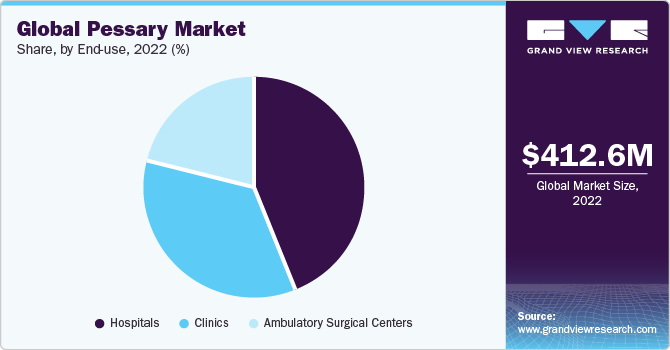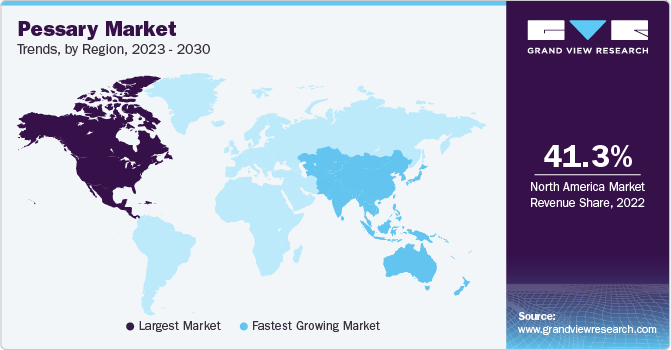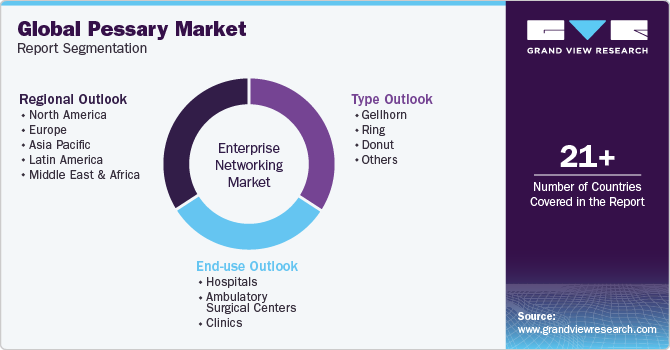- Home
- »
- Medical Devices
- »
-
Pessary Market Size, Share & Trends Analysis Report, 2030GVR Report cover
![Pessary Market Size, Share & Trends Report]()
Pessary Market Size, Share & Trends Analysis Report By Type (Gellhorn, Ring, Donut), By End-use (Hospitals, Ambulatory Surgical Centers, Clinics), By Region, And Segment Forecasts, 2023 - 2030
- Report ID: GVR-4-68038-299-0
- Number of Report Pages: 120
- Format: PDF, Horizon Databook
- Historical Range: 2018 - 2021
- Forecast Period: 2023 - 2030
- Industry: Healthcare
Pessary Market Size & Trends
The global pessary market size was valued at USD 412.6 million in 2022 and is expected to grow at a compound annual growth rate (CAGR) of 4.6% from 2023 to 2030. The increasing prevalence of pelvic organ prolapse, growing geriatric population that is prone to this condition, easy product availability, changing lifestyles, and rapid evolution of noninvasive treatment options are expected to fuel market growth. Stress urine incontinence is higher in patients with poor nutritional status, which results in the weakening of pelvic muscles. Thus, the demand for advanced pelvic support devices is expected to show steep growth in the coming years.

Vaginal pessaries are one of the most preferred treatment options for organ prolapse and incontinence as they are considered simple, affordable, and safe solutions. These factors contribute to a higher patient satisfaction rate as compared to their alternatives. Thus, vaginal pessaries are considered as a first-in-line treatment for pelvic prolapse and/or stress urinary incontinence. Pelvic organ prolapse (POP) affects women of all ages; however, elderly women are more susceptible to POP. As per a 2019 report by the US FDA, the number of women with POP is poised to rise by 46% to 4.9 million by 2050.
Pessaries were preferred as a temporary measure against delayed elective surgeries during COVID-19. However, the overall demand declined greatly during the first pandemic wave, owing to a decrease in the overall footfall in clinics and hospitals during this period. Lockdowns and movement restrictions directly affected production; however, these units started reopening during the third quarter of 2020. The adoption of vaginal pessaries is impacted by factors such as patient discomfort and fear of side effects. To address these issues, regulatory agencies such as the FDA and NICE have developed new guidelines for manufacturers.
Pessaries are in greater demand due to the increased prevalence of pelvic organ prolapse and urine incontinence. As per a November 2021 International Urogynecology Journal article, approximately 40% of women suffer from pelvic organ prolapse (POP). Pessary treatment has demonstrated a high degree of patient satisfaction (75.3%), efficacy (90.7%), and a positive impact on the improvement of vaginal and sexual symptoms, quality of life, and mental health. The same source states that the most commonly used kind of ring pessary that permits sexual activity while retaining less vaginal discharge is the membrane-free variety, which is superior to occlusive (Gellhorn) types or devices.
Frequent product launches, geographical expansions, heavy focus on R&D by market players and universities, and government initiatives are the major factors likely to boost market growth. Cosm Medical Corporation received Health Canada Investigational Testing Authorization (ITA) approval in February 2021 for a clinical study for its Gynethotics customized gynecological prosthetics. Cosm designs the pessary according to a patient's specific anatomy and lifestyle needs with a modernized pelvic floor measurement system, using novel ultrasound imaging technology.
Type Insights
The ring segment dominated the pessary market with a revenue share of 56.9% in 2022. The segment is expected to expand at a significant CAGR throughout the forecast period, owing to factors such as ease of usage and patient comfort. The ring pessary is appropriate for all stages of POP. Clinicians favor ring pessaries because of the simplicity with which they can be inserted and removed. These are most effective in the early stages of prolapse, but they can be used at any stage of pelvic organ prolapse.
Gehrung, shaatz, oval, cube, and shelf are few other pessaries that are widely used. Other support pessaries can be more useful for advanced prolapse but are more difficult for the patient to handle. The device uses suction to support areas that may be sagging or bulging due to prolapse. Most of the pessaries available in the market currently are comprised of silicone, a highly compatible material. It is non-allergenic, long-lasting, autoclavable, and simple to remove & replace. The type of pessary to be used is determined by a number of parameters, including the type and degree of prolapse.
End-use Insights
The hospital segment accounted for the largest market revenue share of 43.7% in 2022. This demand is owing to the extensive use of pessaries in post-operative and bedridden in-patients. Increasing awareness about organ prolapse, urinary incontinence, and inclusion of pessaries in private insurances are some of the factors boosting segment growth. Also, hospitals are adopting minimally invasive procedures for pessary placement to reduce post-operative complications and accelerate the recovery rate.

The clinic segment is expected to witness the fastest CAGR of 5.2% during the forecast period. This can be attributed to affordable pessary fitting procedures, limited stay duration, and higher convenience for the geriatric population in this setting. Ambulatory surgical centers are also expected to grow at a significant rate during the forecast period, on account of the rising awareness about ambulatory centers among the general population.
Regional Insights
North America dominated the market and accounted for the largest revenue share of 41.3% in 2022. The market has a high impact on the region due to factors such as an aging female population, lifestyle changes that cause hormonal disruptions, the rising prevalence of pelvic organ prolapse, and increased health awareness. According to an article in the National Library of Medicine, 3.3 million women in the U.S. experienced pelvic organ prolapse in 2010, and this number is expected to rise to 4.9 million by 2050 due to a probable link with aging.

In Asia Pacific, the market for pessary is expected to witness exponential growth over the forecast period. The regional market's CAGR of 5.4% is expected to be linked to emerging economies, a rapidly aging population, and increased healthcare awareness. The geriatric population is more vulnerable to urinary incontinency and POP, providing a large target market in the region, with Japan, China, and India being the primary regional providers. Additionally, increasing medical tourism is another important element driving the regional market expansion.
Key Companies & Market Share Insights
The market is highly competitive, marked by the presence of a large number of domestic as well as international players. Some of the key strategic initiatives undertaken by market players include new product development, mergers, acquisitions, partnerships, and collaborations. For instance, the Arabin Cerclage pessary was developed by the Germany-based Dr. Arabin GmbH to support the cervical area in pregnant women who are at risk of preterm labor.
Key Pessary Companies:
- CooperSurgical Inc.
- Bliss GVS Pharma
- MedGyn
- Panpac Medical Corporation
- Bioteque America
- Personal Medical Corporation
- Dr. Arabin GmbH & Co. KG
- Integra LifeSciences
- Wallach Surgical Devices
Recent Developments
-
In December 2022, Integra LifeSciences Holdings Corporation announced that it had successfully acquired Surgical Innovation Associates (SIA)
-
In November 2021, CooperSurgical, Inc. announced the signing of a definitive purchase agreement to acquire Generate Life Sciences, a notable name in the space of cryopreservation of donor eggs and sperm for use in fertility treatments, as well as the storage of newborn stem cells (cord blood & tissue)
Pessary Market Report Scope
Report Attribute
Details
Market size value in 2023
USD 431.0 million
Revenue forecast in 2030
USD 590.5 million
Growth Rate
CAGR of 4.6% from 2023 to 2030
Base year for estimation
2022
Historical data
2018 - 2021
Forecast period
2023 - 2030
Report updated
December 2023
Quantitative units
Revenue in USD million and CAGR from 2023 to 2030
Report coverage
Revenue forecast, company ranking, competitive landscape, growth factors, and trends
Segments covered
Type, end-use, region
Regional scope
North America; Europe; Asia Pacific; Latin America; MEA
Country scope
U.S.; Canada; UK; Germany; France; Italy; Spain; Denmark; Sweden; Norway; Japan; China; India; Australia; South Korea; Thailand; Brazil; Mexico; Argentina; Saudi Arabia; South Africa; UAE; Kuwait
Key companies profiled
CooperSurgical Inc.; Bliss GVS Pharma; MedGyn; Panpac Medical Corporation; Bioteque America; Personal Medical Corporation; Dr. Arabin GmbH & Co. KG; Integra LifeSciences; Wallach Surgical Devices
Customization scope
Free report customization (equivalent to up to analyst’s working days) with purchase. Addition or alteration to country, regional & segment scope
Pricing and purchase options
Avail customized purchase options to meet your exact research needs. Explore purchase options
Global Pessary Market Report Segmentation
This report forecasts revenue growth at the global, regional, and country levels and provides an analysis of the latest industry trends in each of the sub-segments from 2018 to 2030. For this study, Grand View Research has segmented the global pessary market report on the basis of type, end-use, and region:

-
Type Outlook (Revenue, USD Million, 2018 - 2030)
-
Gellhorn
-
Ring
-
Donut
-
Others
-
-
End-use Outlook (Revenue, USD Million, 2018 - 2030)
-
Hospitals
-
Ambulatory Surgical Centers
-
Clinics
-
-
Regional Outlook (Revenue, USD Million, 2018 - 2030)
-
North America
-
U.S.
-
Canada
-
Europe
-
UK
-
Germany
-
France
-
Italy
-
Spain
-
Denmark
-
Sweden
-
Norway
-
-
Asia Pacific
-
Japan
-
China
-
India
-
Australia
-
Thailand
-
South Korea
-
-
Latin America
-
Brazil
-
Mexico
-
Argentina
-
-
Middle East & Africa
-
South Africa
-
Saudi Arabia
-
UAE
-
Kuwait
-
-
Frequently Asked Questions About This Report
b. The global pessary market size was estimated at USD 412.6 million in 2022 and is expected to reach USD 431.0 million in 2023.
b. The global pessary market is expected to grow at a compound annual growth rate of 4.6% from 2023 to 2030 to reach USD 590.5 million by 2030.
b. North America dominated the pessary market with a share of 41.3% in 2022. This is attributed to factors such as strong medical infrastructure, high chronic disease burden, and advancements in minimally invasive procedures.
b. Some key players operating in the pessary market include MedGyn Products, Inc.; PanPac Medical; Thomas Medical, Wallach Surgical Devices.; and Bioteque America.
b. The increasing number of chronic respiratory diseases, growing prevalence of obesity, and rising geriatric population along with the growing prevalence of organ prolapse are some of the key factors that are driving the pessary market growth.
Share this report with your colleague or friend.
![gvr icn]()
NEED A CUSTOM REPORT?
We can customize every report - free of charge - including purchasing stand-alone sections or country-level reports, as well as offer affordable discounts for start-ups & universities. Contact us now
![Certified Icon]()
We are GDPR and CCPA compliant! Your transaction & personal information is safe and secure. For more details, please read our privacy policy.
We are committed towards customer satisfaction, and quality service.
"The quality of research they have done for us has been excellent."





